
Japan Photography
Explore photos and posts tagged Japan.


Evening at Yoyogi Station
As dusk settles over Shibuya, the illuminated sign of Yoyogi Station (代々木駅) glows against a deep indigo sky, marking one of Tokyo’s key JR East commuter hubs. Opened in 1906, Yoyogi serves both the Yamanote and Chuo-Sobu lines, connecting thousands of travelers daily between Shinjuku and Harajuku. The cool blue hour lighting highlights the crisp white façade and the green JR branding, captured here with a balanced exposure to preserve both architectural detail and ambient light reflections. Taken in early evening with a 35mm f/1.8 lens, this frame emphasizes the quiet rhythm of Tokyo’s rush hour just before nightfall.

North Gate at Nippori Station in Tokyo
Passengers move through the North Gate of JR Nippori Station, a key interchange for the Yamanote, Keihin-Tohoku, and Joban lines as well as the Nippori–Toneri Liner. Prominent yellow JR East signage directs travelers toward the West Exit for Yanaka and the East Exit for Ueno. The open, modern concourse design reflects Nippori’s role as both a commuter hub and gateway to nearby traditional neighborhoods.

Yamanote Line sign in Tokyo
A sign for the JR Yamanote Line displays the inner loop direction toward Tabata, Ikebukuro, Shinjuku, and Shibuya. The familiar green design and “JY” line code mark one of Tokyo’s busiest and most important rail routes, which circles the city’s central districts. The bilingual signage reflects Japan Rail’s standardized system for navigation across Tokyo’s dense network of stations.

Owl at a Tokyo Owl Cafe
Owls seen at an Owl Cafe in Tokyo, Japan.

Afternoon at Kyoto Station Platforms
Multiple sets of railway tracks converge toward the distance beneath a grid of steel catenary supports. A man in a dark suit walks along the yellow tactile line on Platform 4, while another commuter waits across the tracks. Overhead signs mark platform numbers, and signal lights display red and amber. The station canopy and surrounding buildings form an industrial backdrop, with a faint view of hills beyond the city.
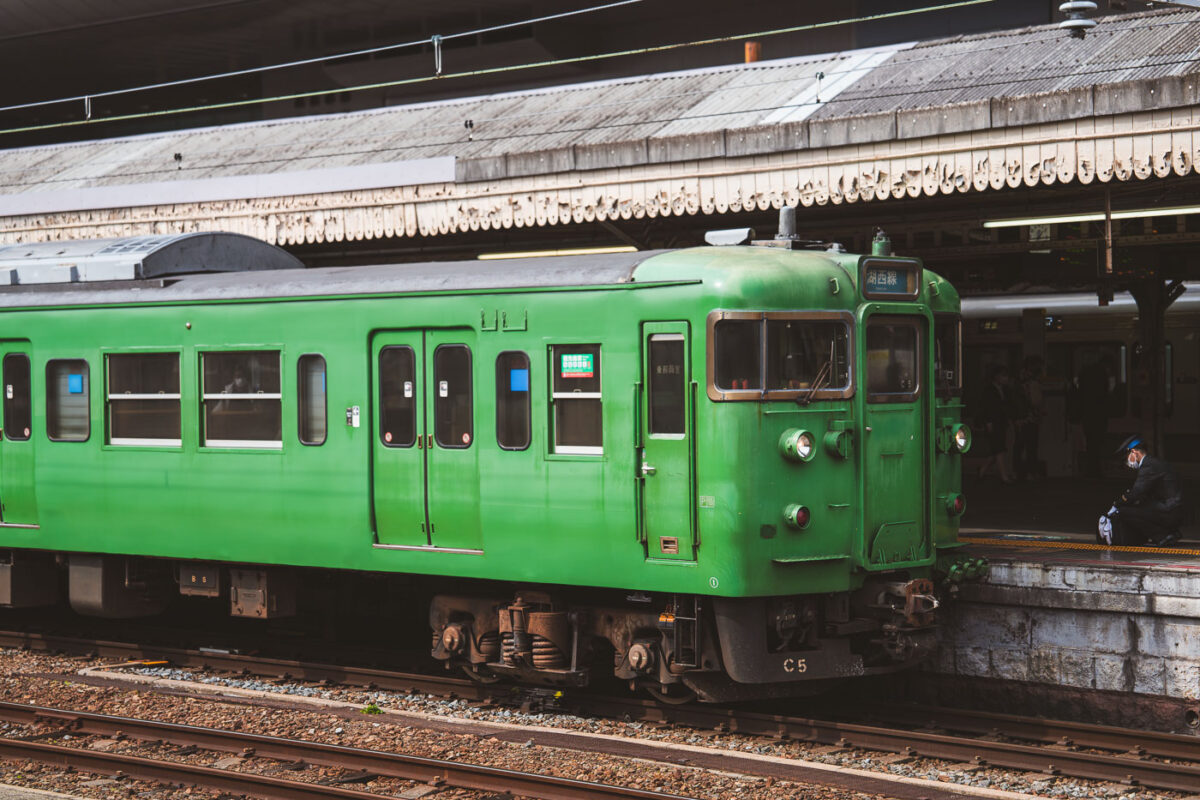
Kyoto Train Car
A classic green Japanese commuter train sits at a station platform, its utilitarian design and weathered paint evoking an earlier era of rail travel. These older local-line cars, once common throughout regional Japan, continue to serve smaller routes with reliability and simplicity. The muted tones of the train and station canopy, along with a uniformed conductor preparing for departure, create a nostalgic glimpse into the everyday rhythm of Japan’s vast and enduring railway network.
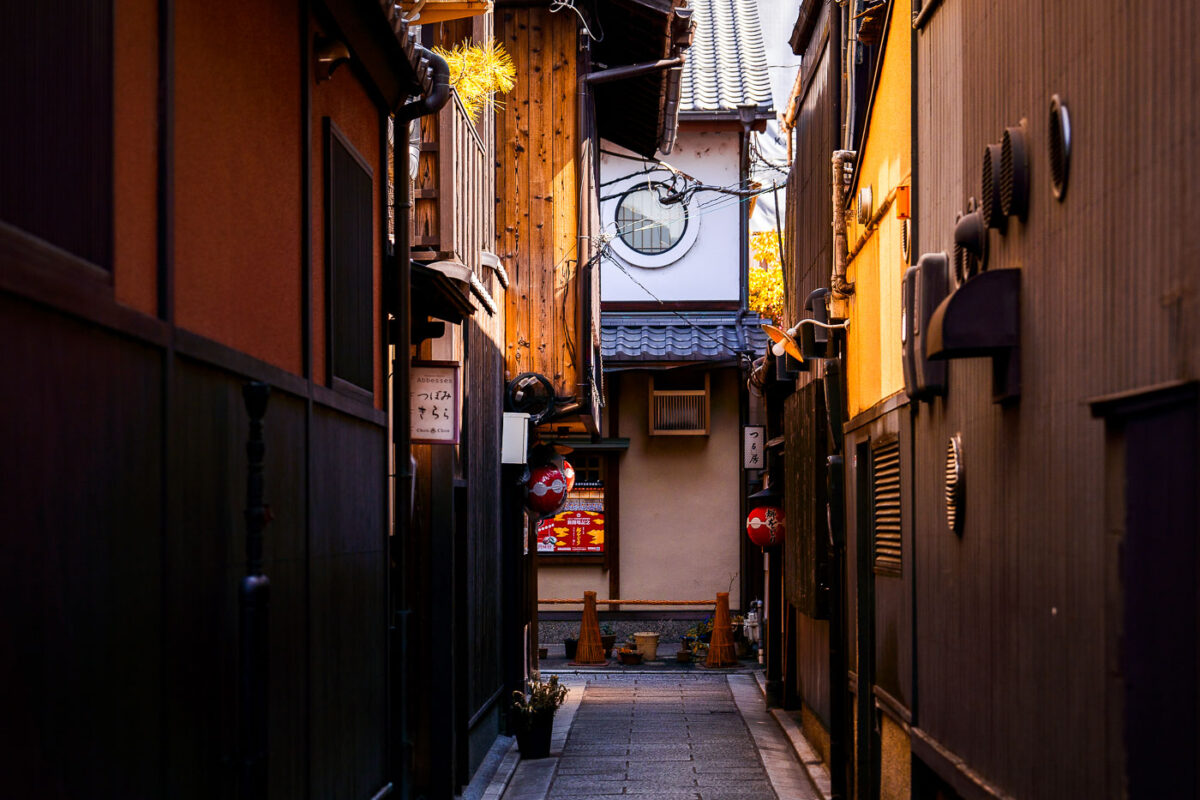
Narrow Alley off Hanamikoji-dori in Kyoto
A narrow side alley branching off Hanamikoji-dori in Kyoto’s Gion district, photographed in March 2023. This historic area is known for its preserved machiya townhouses—traditional wooden buildings that date back to the Edo and Meiji periods and once served as both residences and storefronts for merchants and artisans. Many of the structures visible here retain their classic features, including wooden latticework (koshi), earthy plaster walls, deep-eaved roofs, and lanterns marking the entrances of small eateries and teahouses.
Hanamikoji-dori remains closely associated with Kyoto’s hanamachi culture, where geiko and maiko still work in nearby teahouses. While the main street draws steady foot traffic, the smaller lanes behind it—like the one pictured—capture the quieter, more atmospheric side of Gion, where the scale of the architecture narrows and the district’s centuries-old urban fabric becomes especially clear.

Vintage Japanese Post Box in Kyoto
A cylindrical orange post box on a street in Kyoto, photographed in March 2023. This style of mailbox—introduced in the early 1900s during Japan’s push to modernize its postal infrastructure—became a familiar feature across the country through the mid-20th century. Its rounded form and front mail slot were designed to be durable, weather-resistant, and easy to recognize even in densely built neighborhoods.
Although newer rectangular mailboxes are now common in urban areas, many historic districts in Kyoto retain these older designs to preserve the traditional streetscape. Today, they continue to function as part of Japan Post’s network, blending everyday utility with a tangible link to the city’s architectural and civic history.
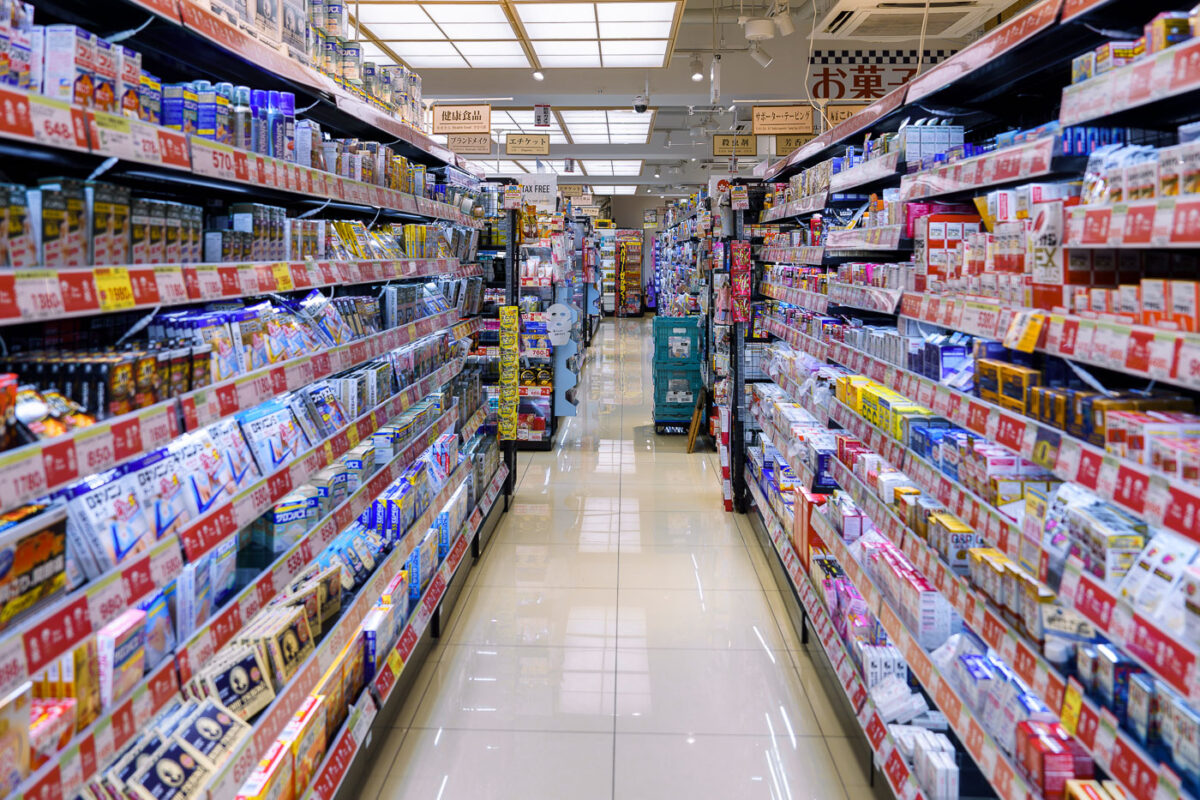
Aisles Inside a Tokyo Convenience Store
A well-stocked aisle inside a convenience store in Tokyo, photographed in March 2023. Japan’s major chains—such as Lawson, FamilyMart, and 7-Eleven—are known for their dense product layouts, where shelves are filled with everything from health supplements and over-the-counter medicines to snacks, instant meals, and travel essentials.
Convenience stores, or konbini, have played an important role in daily urban life since rapid expansion in the 1980s, providing reliable 24-hour access to food, bill-paying services, parcel pickup, and seasonal goods. Their efficient layouts and constant product rotation reflect Japan’s retail culture, where limited-edition items, regional flavors, and promotional displays are updated weekly to match demand and maximize shelf use.
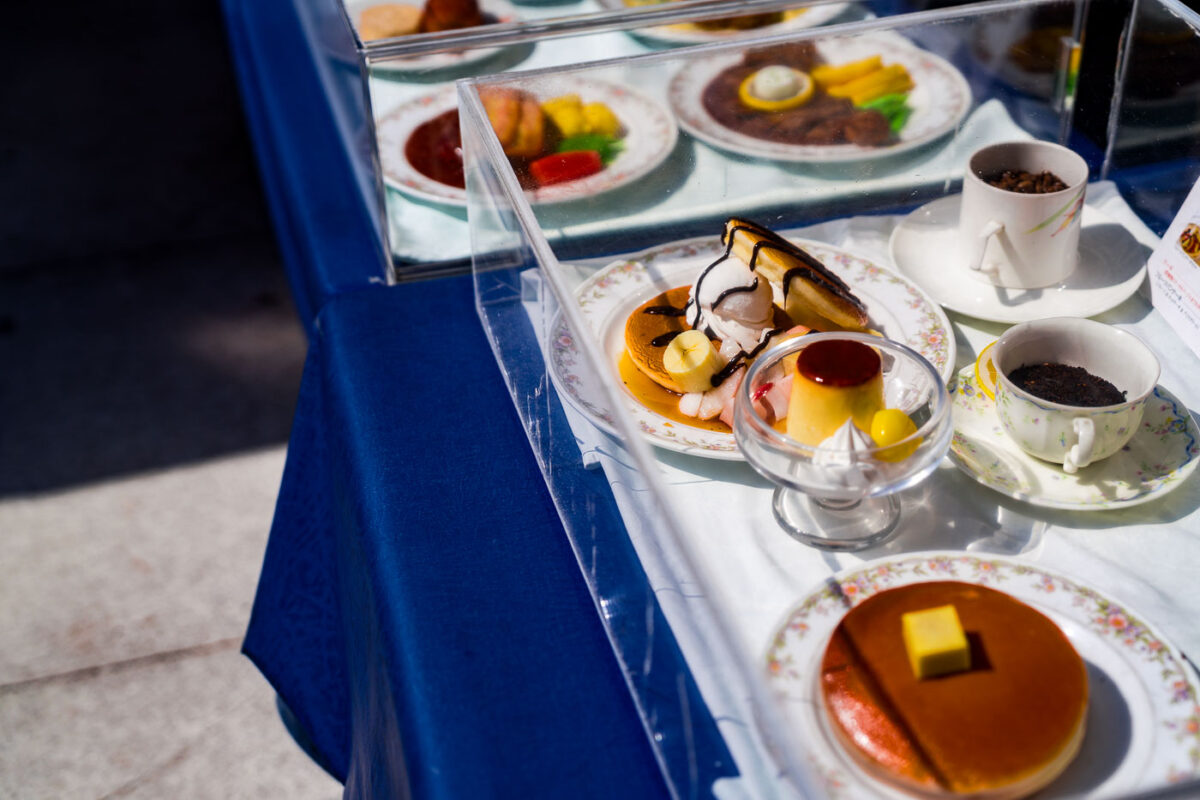
Shokuhin Sampuru Display in Osaka
A display of shokuhin sampuru—hyper-realistic plastic food models—outside a café in Osaka. These handcrafted replicas have been a fixture of Japanese dining culture since the early 20th century, originally created to help restaurants communicate menu items to customers at a time when Western dishes were still unfamiliar to many diners.
The models shown here include classic café desserts such as pancakes, pudding, and parfait toppings, each sealed in protective cases to preserve their lacquered shine. Osaka remains one of the country’s major production centers for sampuru, where artisans still sculpt and paint many pieces by hand to ensure the lifelike detail that continues to define this uniquely Japanese craft.

Shirakawa Stream from Tatsumibashi Bridge
A view along the Shirakawa Stream from the Tatsumibashi Bridge in Kyoto’s Gion district, photographed in March 2023. This narrow waterway flows parallel to Shijo-dori and is lined with traditional wooden machiya, many of which date back to the early 20th century and once housed teahouses and restaurants serving the geiko and maiko communities.
The Shirakawa area has long been considered one of Kyoto’s most atmospheric neighborhoods, with stone embankments, bamboo fencing, and low bridges that reflect centuries of urban design shaped around natural waterways. Although the cherry trees here remain bare in early spring, this stretch becomes one of Kyoto’s most visited spots during sakura season, when blossoms arch over the stream and lantern-lit evenings draw crowds from around the world.
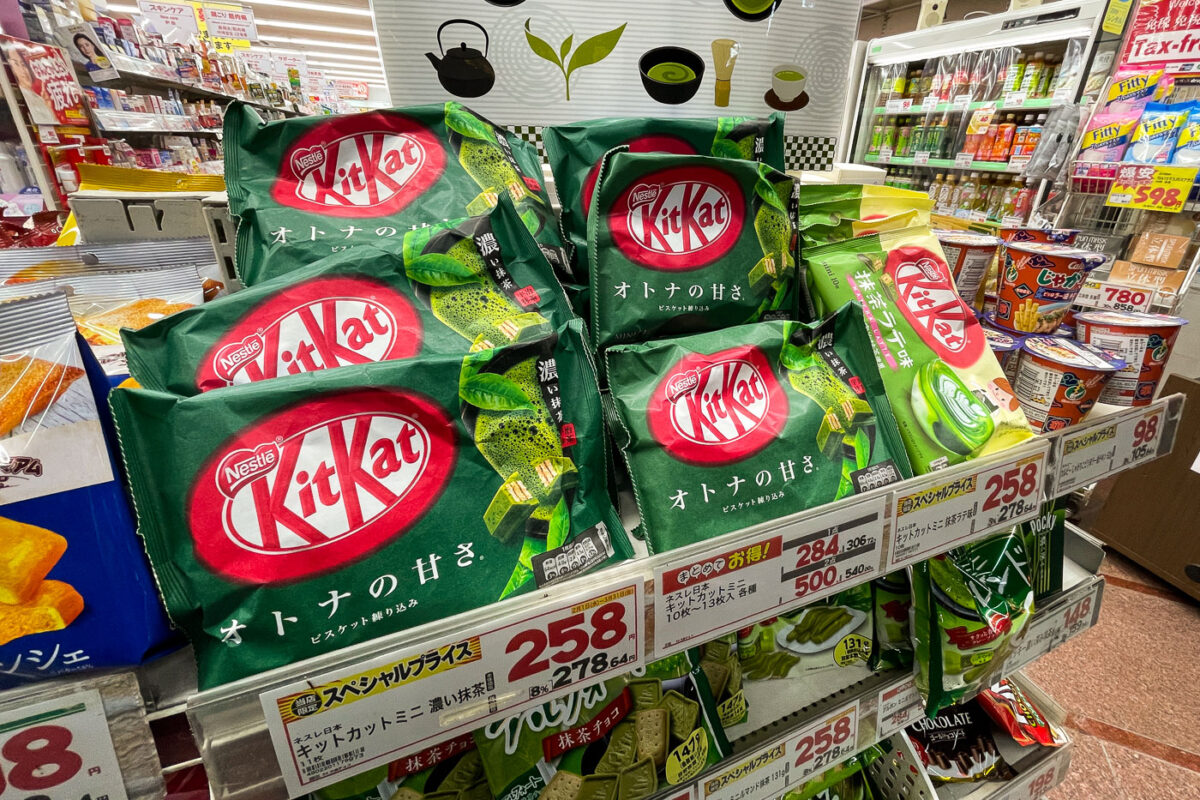
Matcha KitKats in a Tokyo Convenience Store
A shelf lined with matcha-flavored KitKats in a Tokyo convenience store — a distinctly Japanese twist on a global snack. The bold green packaging, accented by the signature red logo, promotes Nestlé’s “Otona no Amasa” (Adult Sweetness) series, a richer, less sugary variant aimed at mature tastes. Japan’s endless flavor variations, from wasabi to sake, have turned KitKats into a collector’s item for travelers and locals alike. The display, organized yet bursting with color, captures the vibrant consumer culture of Japan’s konbini — where even a quick snack reflects national creativity and curiosity.

Shiyakusho-mae Station on the Tozai Line in Kyoto Japan
A quiet moment inside the Kyoto City Subway at Shiyakusho-mae Station, where the red-lined doors and bright vending machines reflect the city’s clean, orderly transit design. The tiled floors, yellow tactile paving, and minimalist signage embody the practical beauty of Japanese public infrastructure. Empty corridors like this highlight the calm rhythm of off-peak urban life in Kyoto.
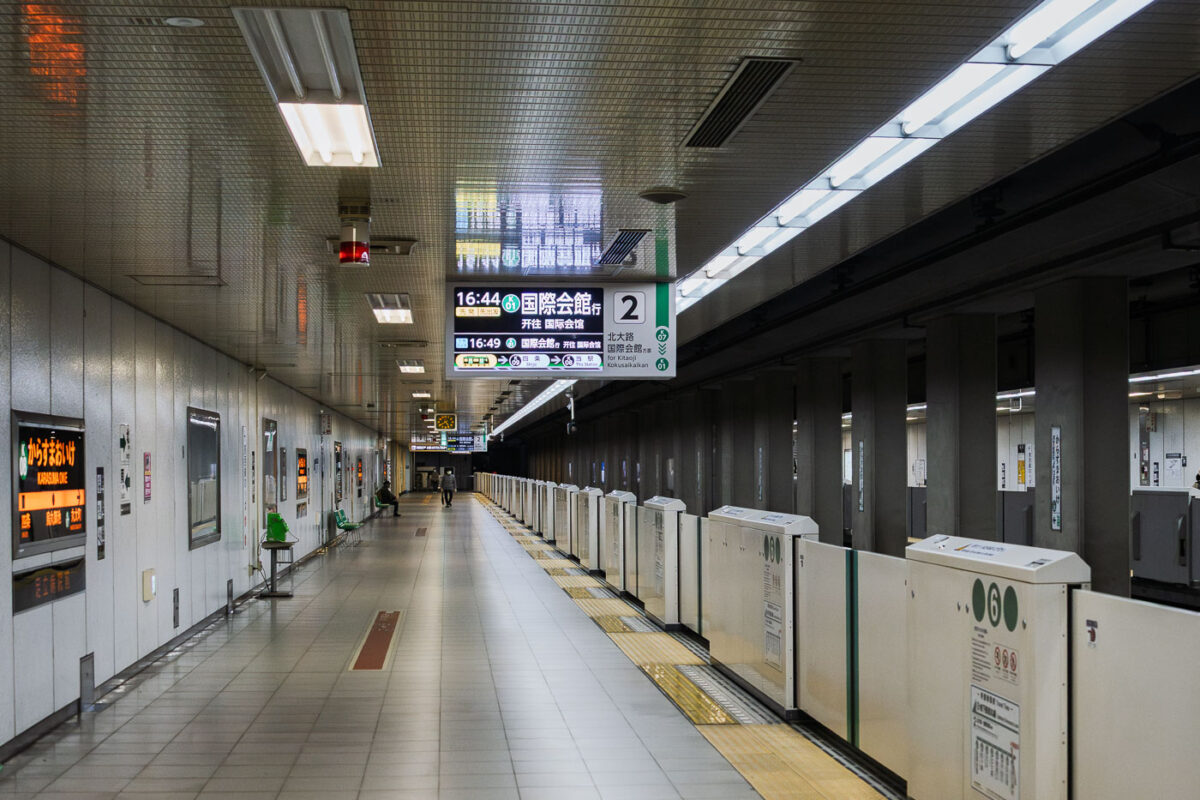
Karasuma Oike Station Platform, Kyoto
A quiet moment on the platform at Karasuma Oike Station, one of the key interchange points within the Kyoto Municipal Subway system. Opened in 1981 as part of the Karasuma Line, the station later became a transfer hub when the Tōzai Line opened in 1997, creating a central east–west and north–south connection beneath Kyoto’s urban core.
The platform features platform-edge doors—introduced across Kyoto’s subway network to improve safety and accessibility—along with digital signage that displays through-service connections toward the northern suburbs and toward the International Conference Center. Located beneath the intersection of Karasuma-dōri and Oike-dōri, the station plays an important role in linking government offices, business districts, and cultural areas throughout central Kyoto.
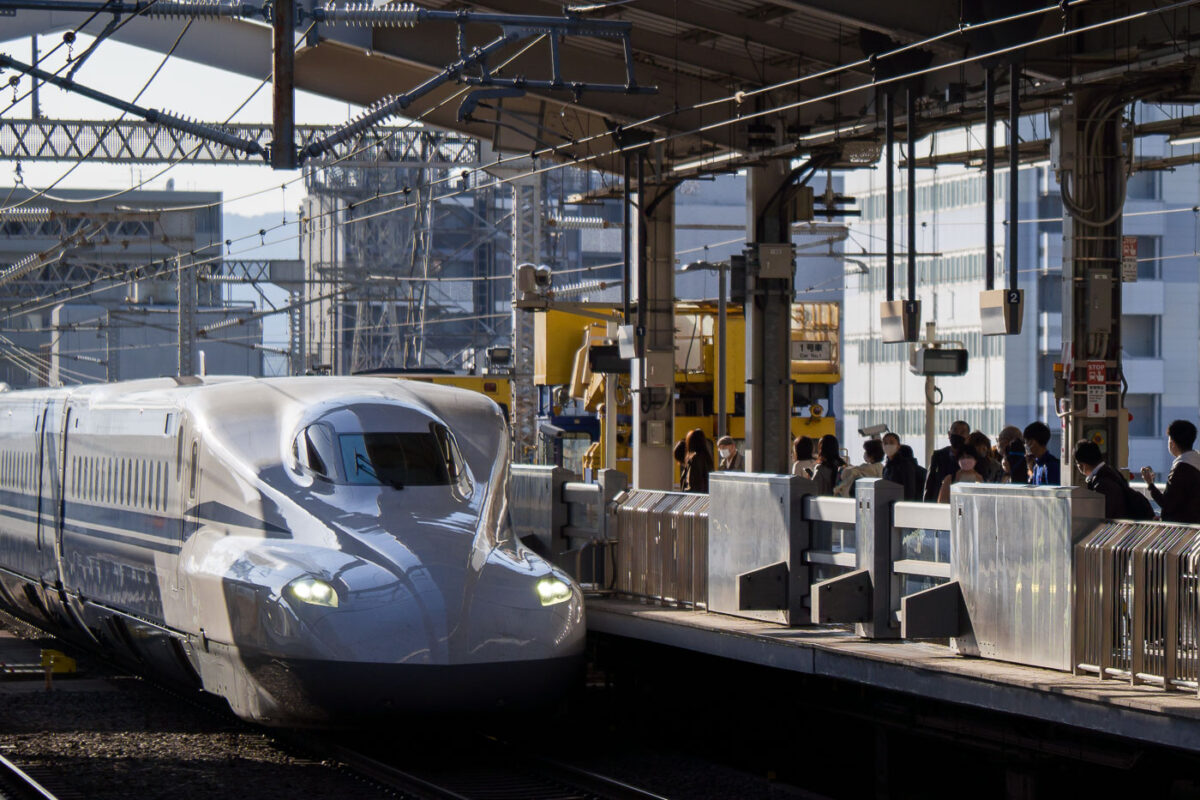
N700A Shinkansen Arriving at Kyoto Station
An N700A-series Shinkansen arrives at Kyoto Station, one of the busiest hubs on the Tōkaidō and San’yō Shinkansen network. Introduced by JR Central as an upgraded variant of the earlier N700 design, the N700A incorporated improved braking, enhanced bogies, and automatic train control refinements, supporting smoother high-speed operation along Japan’s primary intercity corridor.
Kyoto Station has served Shinkansen services since 1964, when the original Tōkaidō Line opened for the Tokyo–Osaka route ahead of the Tokyo Olympics. Today it remains a major interchange for regional and long-distance rail, handling millions of passengers annually traveling between Kansai, Tokyo, and the Chūgoku region.
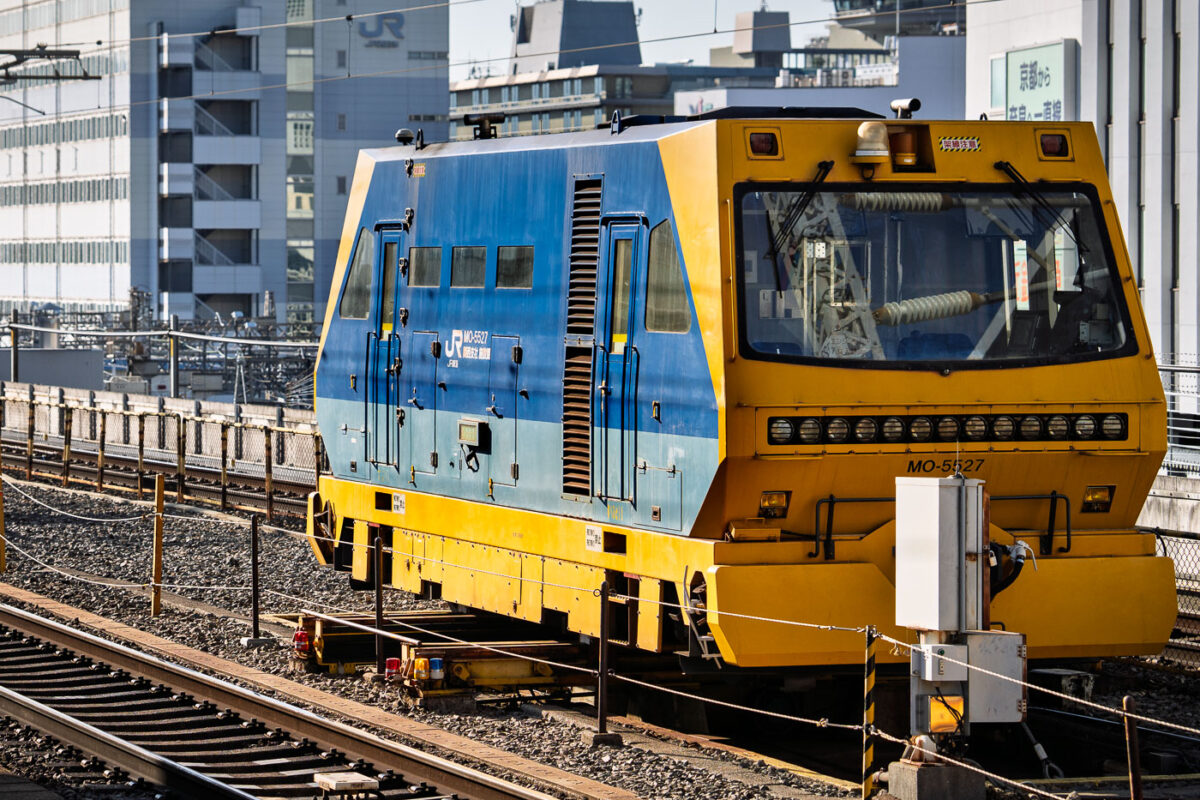
Industrial Maintenance Train, Kyoto
A JR West track maintenance vehicle stands on an elevated railway in Kyoto, painted in bright yellow and blue. These machines are vital to Japan’s rail network, used for track inspection, alignment, and upkeep during off-peak hours. The geometric design and industrial strength of the vehicle contrast with the dense urban surroundings, illustrating Japan’s precision engineering and efficiency in rail transport.

Claw Machines at Gigo Akihabara
Inside the multi-floor Gigo arcade complex in Akihabara, photographed in March 2023, rows of brightly lit crane and prize machines fill an entire level dedicated to character-themed merchandise and limited-run collectibles. Facilities like this became a defining part of Akihabara’s post-2000s shift from an electronics-focused district to a broader entertainment hub centered around gaming, anime culture, and specialty retail.
Originally operated under the SEGA brand until a 2022 rebranding, Gigo retained the large-scale arcade format that has long been a staple of Tokyo’s urban leisure landscape. The popularity of crane games—often refreshed with seasonal or collaboration prizes—continues to draw both local players and visitors exploring the district’s modern pop-culture identity.
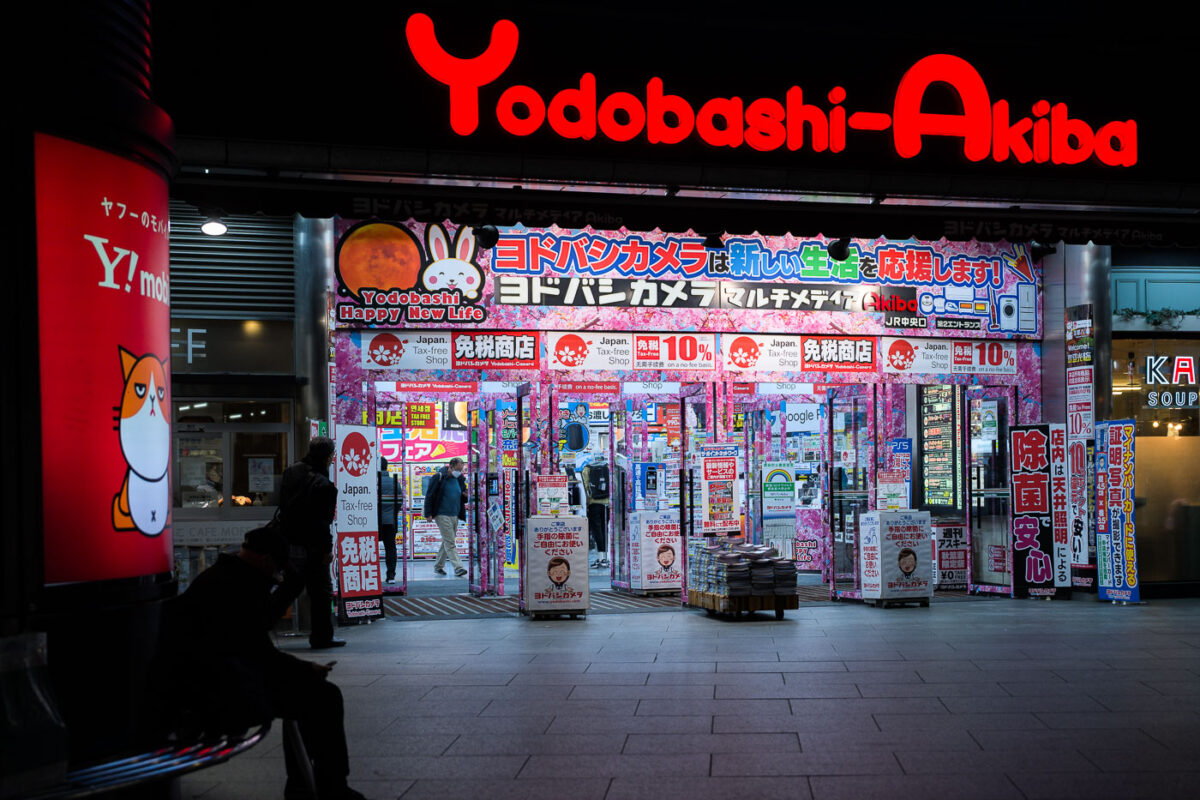
Yodobashi-Akiba Exterior at Night
Yodobashi-Akiba, photographed in March 2023, is one of Tokyo’s largest electronics retail complexes and a major landmark in the Akihabara district. Opened in 2005 as part of a wider redevelopment effort around JR Akihabara Station, the multi-story store consolidated several specialty floors—computers, cameras, gaming, home appliances, musical instruments—into a single destination that helped redefine the area’s retail identity in the 2000s.
Its brightly illuminated entrance, typically covered in seasonal and promotional signage, reflects the competitive electronics market that shaped modern Akihabara. The building also connects directly to the Tsukuba Express line and sits beside the redevelopment zone that transformed the district from its postwar reputation as “Electric Town” into a mix of technology retail, office towers, and entertainment venues.
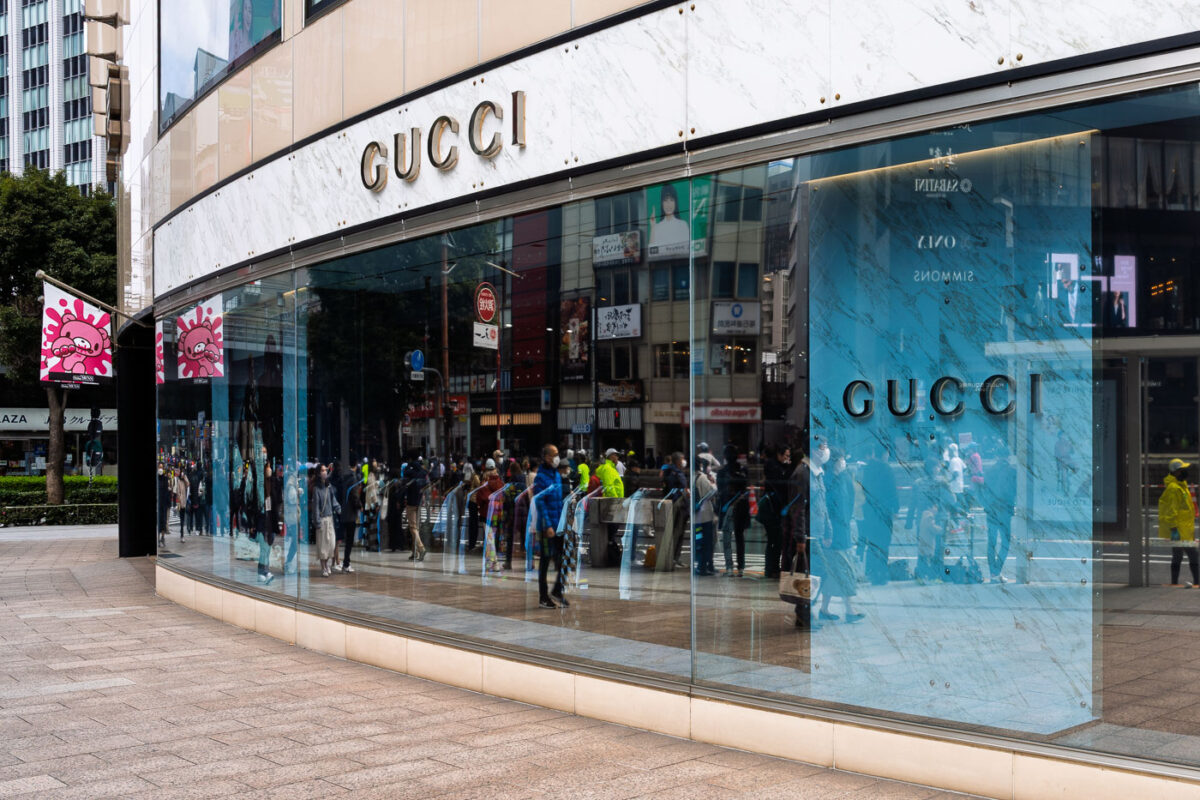
Reflections at Gucci Ginza
Marathon runners outside the Gucci flagship store in Tokyo’s Ginza district, their reflections merging with the pale blue marble of the storefront’s curved glass façade. The mirrored surface creates a layered composition — a city within a window — blending luxury retail architecture with the urban motion of shoppers and commuters. Behind the glass, soft interior lighting contrasts with the bustle outside, capturing a quiet tension between aspiration and reality. The scene evokes Ginza’s dual identity as both a symbol of global consumer culture and a distinctly Japanese streetscape, where design, commerce, and reflection coexist seamlessly.